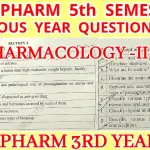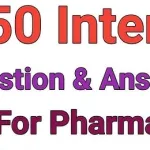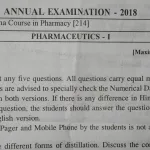Here are 50 pharmacovigilance interview questions along with answers:
1. What is pharmacovigilance?
Answer: Pharmacovigilance is the science and activities relating to the detection, assessment, understanding, and prevention of adverse effects or any other drug-related problem.
2. Why is pharmacovigilance important?
Answer: Pharmacovigilance ensures patient safety by monitoring, evaluating, and responding to adverse drug reactions (ADRs) and other drug-related problems, ultimately improving drug safety and efficacy.
3. What is the difference between an adverse event (AE) and an adverse drug reaction (ADR)?
Answer: An AE is any untoward medical occurrence that happens during treatment but is not necessarily related to the drug, while an ADR is a harmful and unintended reaction to a drug at normal doses.
4. What are the main sources of adverse event reports?
Answer: Main sources include healthcare professionals, patients, clinical trials, literature, regulatory authorities, and spontaneous reporting systems.
5. What is the role of the WHO in pharmacovigilance?
Answer: The WHO supports the global harmonization of pharmacovigilance practices, provides guidelines, coordinates international reporting systems, and runs the WHO Program for International Drug Monitoring.
6. What is a serious adverse event (SAE)?
Answer: An SAE is any untoward medical occurrence that results in death, life-threatening conditions, hospitalization, disability, or congenital anomaly.
7. What is a signal in pharmacovigilance?
Answer: A signal is information that suggests a new potential association between a drug and an adverse event that needs further investigation and validation.
8. What is causality assessment?
Answer: Causality assessment is the process of evaluating the likelihood that a drug caused or contributed to an adverse event.
9. What is a Risk Management Plan (RMP)?
Answer: An RMP outlines strategies for monitoring, managing, and minimizing the risks associated with a drug, ensuring that the benefits outweigh the risks.
10. What is the difference between pre-marketing and post-marketing pharmacovigilance?
Answer: Pre-marketing involves safety monitoring during clinical trials, while post-marketing involves monitoring the safety of a drug once it is available to the public.
11. What is EudraVigilance?
Answer: EudraVigilance is the European Medicines Agency’s system for managing and analyzing information on suspected ADRs for medicines authorized in the European Economic Area.
12. What is the purpose of Periodic Safety Update Reports (PSURs)?
Answer: PSURs provide a comprehensive review of a drug’s safety profile at regular intervals to ensure ongoing evaluation of risks and benefits during the product’s lifecycle.
13. What is the ICH E2E guideline?
Answer: The ICH E2E guideline outlines the principles of pharmacovigilance planning to ensure risk management during clinical trials and post-marketing surveillance.
14. What is the difference between MedDRA and WHO-ART?
Answer: MedDRA is a comprehensive and standardized medical terminology used globally for regulatory communication, while WHO-ART (World Health Organization Adverse Reaction Terminology) is an older, less detailed system.
15. What are the types of ADRs?
Answer: ADRs are categorized into Type A (predictable, dose-related) and Type B (unpredictable, idiosyncratic).
16. What is the role of a Qualified Person for Pharmacovigilance (QPPV)?
Answer: The QPPV is responsible for the oversight of a company’s pharmacovigilance system and ensuring that regulatory authorities are informed of any safety concerns.
17. What are the key elements of a pharmacovigilance system?
Answer: The key elements include adverse event reporting, signal detection, risk management, periodic safety reporting, and regulatory compliance.
18. What is the Yellow Card Scheme?
Answer: The Yellow Card Scheme is the UK’s system for collecting and monitoring information on suspected ADRs to medicines.
19. What is the difference between a spontaneous report and a solicited report?
Answer: A spontaneous report is voluntarily submitted by healthcare professionals or patients, while a solicited report is generated during organized data collection systems like clinical trials or surveys.
20. What is Good Pharmacovigilance Practice (GVP)?
Answer: GVP refers to a set of measures to ensure robust safety monitoring and management of risks associated with pharmaceutical products.
21. What is the CIOMS form?
Answer: The CIOMS form is an internationally recognized format for reporting serious adverse events during clinical trials.
22. What is a pharmacovigilance audit?
Answer: A pharmacovigilance audit is an evaluation of the compliance and effectiveness of a pharmacovigilance system to ensure regulatory standards are met.
23. What is PSUR submission frequency for new drugs?
Answer: PSURs are usually submitted every 6 months for the first 2 years, then annually for the following 3 years, and after that every 5 years unless otherwise specified by regulatory authorities.
24. What is meant by ‘benefit-risk balance’ in pharmacovigilance?
Answer: Benefit-risk balance refers to weighing the therapeutic benefits of a drug against its potential risks to determine its overall value.
25. What is a signal detection algorithm in pharmacovigilance?
Answer: Signal detection algorithms use statistical methods to identify potential safety signals by analyzing large volumes of adverse event data.
26. What is a Dear Doctor Letter?
Answer: A Dear Doctor Letter is a communication sent by pharmaceutical companies or regulatory authorities to healthcare professionals about important drug safety information.
27. How are pregnancy outcomes monitored in pharmacovigilance?
Answer: Pregnancy outcomes are monitored through pregnancy registries that collect data on drug exposure and outcomes to ensure safety for both mother and fetus.
28. What is an expedited reporting requirement?
Answer: Expedited reporting refers to the requirement to report serious, unexpected adverse events to regulatory authorities within a specified timeframe (typically 15 days).
29. What is the role of pharmacovigilance in clinical trials?
Answer: Pharmacovigilance during clinical trials involves monitoring safety data, reporting adverse events, and ensuring proper risk management strategies are in place.
30. What is REMS (Risk Evaluation and Mitigation Strategy)?
Answer: REMS is a program required by the FDA for certain medications to ensure that the benefits of a drug outweigh its risks.
31. What is an Individual Case Safety Report (ICSR)?
Answer: An ICSR is a detailed report of a single patient’s adverse event experience submitted to regulatory authorities.
32. What is the purpose of signal management?
Answer: Signal management involves detecting, validating, and assessing potential drug safety signals to determine if further action or regulatory communication is required.
33. What is a pharmacovigilance inspection?
Answer: A pharmacovigilance inspection is an official review conducted by regulatory authorities to assess the compliance and effectiveness of a company’s pharmacovigilance system.
34. What is literature screening in pharmacovigilance?
Answer: Literature screening is the process of monitoring scientific publications to identify potential adverse events or safety signals related to a drug.
35. What is a pharmacovigilance agreement (PVA)?
Answer: A PVA is a formal contract between pharmaceutical companies or partners outlining their pharmacovigilance responsibilities and processes for a shared product.
36. What is the role of the FDA’s MedWatch program?
Answer: MedWatch is the FDA’s system for receiving reports of adverse events and safety concerns related to medical products, including drugs and devices.
37. What is the concept of a nocebo effect in pharmacovigilance?
Answer: The nocebo effect refers to negative effects experienced by a patient that are related to their expectations of harm rather than the actual pharmacological effects of a drug.
38. How is data mining used in pharmacovigilance?
Answer: Data mining is used to analyze large pharmacovigilance databases to detect patterns, correlations, or signals of potential safety concerns.
39. What is post-authorization safety study (PASS)?
Answer: PASS is a study conducted after a drug is authorized to collect additional information about its safety profile.
40. What is a Drug Safety Update Report (DSUR)?
Answer: A DSUR provides a periodic assessment of the safety of a drug under investigation, required annually during the clinical trial phase.
41. What is the difference between a passive and an active pharmacovigilance system?
Answer: A passive system relies on spontaneous reporting, whereas an active system proactively seeks out information through surveys, studies, or monitoring programs.
42. What is a black box warning?
Answer: A black box warning is the FDA’s strictest warning for drugs with significant risk of serious or life-threatening adverse effects.
43. What is the purpose of pharmacovigilance training?
Answer: Pharmacovigilance training ensures that staff are knowledgeable about drug safety regulations, adverse event reporting, and risk management practices.
44. What is the CIOMS Working Group?
Answer: The CIOMS Working Group provides international guidelines on pharmacovigilance, improving practices and harmonizing regulations across different regions.
45. What is signal validation in pharmacovigilance?
Answer: Signal validation is the process of confirming that a potential signal of drug safety is credible, supported by data, and warrants further investigation.
46. What is a pharmacovigilance database?
Answer: A pharmacovigilance database is a system used to store, manage, and analyze adverse event reports and drug safety information.
47. What is disproportionality analysis?
Answer: Disproportionality analysis is a statistical method used to detect signals by comparing the observed and expected frequencies of adverse events in a pharmacovigilance database.
48. What is an example of a global pharmacovigilance regulation?
Answer: An example is the European Union’s Regulation (EC) No 726/2004, which establishes rules for monitoring the safety of medicinal products in the EU.
49. How do you manage duplicate adverse event reports?
Answer: Duplicate reports are identified by matching criteria (e.g., patient details, drug, event) and then merged to avoid inflating safety signals.
50. How is artificial intelligence being used in pharmacovigilance?
Answer: AI is used for data mining, signal detection, and analyzing large sets of adverse event reports to improve efficiency and accuracy in pharmacovigilance processes.
These questions and answers will provide a strong foundation for understanding key concepts in pharmacovigilance during interviews.
Latest Posts
- Step-by-step guide to download and apply for jee mains admit card 202
- Comprehensive 2025 government holidays and recruitment details for job seekers
- JEE Mains Admit Card 2025: Your Step-by-Step Guide to Downloading the Hall Ticket
- Everything You Need to Know About 2025 Government Holidays Recruitment
- Comprehensive Guide to rrb d group recruitment 2025 – Eligibility, Vacancies, and Application
- Detailed guide to nps trust recruitment 2025 vacancies, eligibility and apply process
- Comprehensive guide to hpcl recruitment 2025 notification, vacancies, and application process
- ignou bed admission 2025 complete recruitment guide with eligibility and process
- Comprehensive Guide to Indian Army Agniveer Recruitment 2025 Notification and Jobs
- Everything You Must Know About CBSE Board Exams 2025 Changes & New Rules






